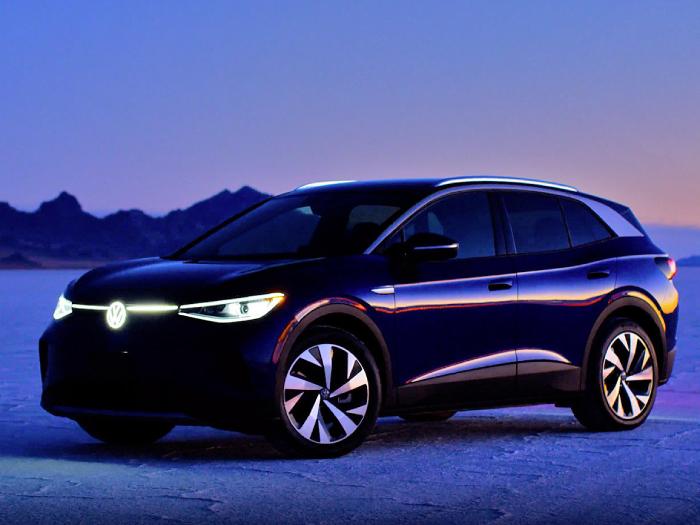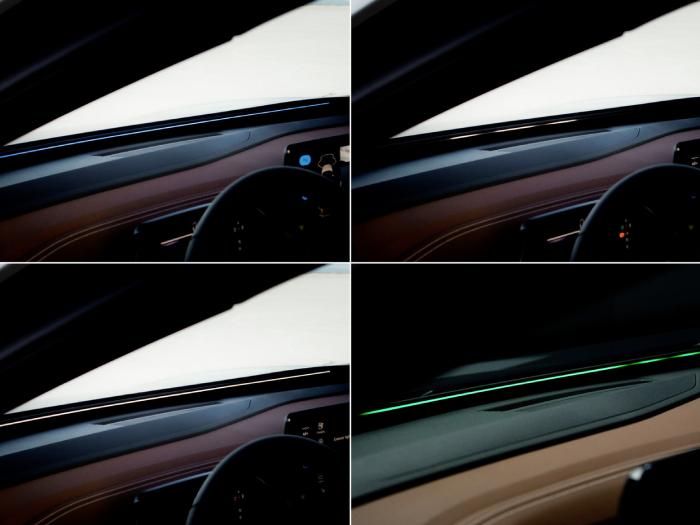ID. Light: intuitive driver-vehicle communication
A strip of multi-coloured LEDs along the underside of the windscreen communicates with the driver and front passenger via light pulses that provide information while avoiding distractions. The ID. Light is standard on the ID. family of models.
Digital assistants are an increasing part of our everyday lives: they play us our favourite songs on demand, tell us the weather and control the heating and lights in our homes. Frequently they use light symbols, such as a coloured ring, to show whether they are receiving or communicating directly with us.
The ID. range of models features similar technology in the form of ID. Light, a narrow light strip designed to assist the occupants of the vehicle intuitively. The ID. Light uses different light pulses to signal whether the car is ready to drive or if the battery is being charged; they also highlight the direction suggested by the navigation system.
Intuitive communication

The ID.3 and ID.4 are the first Volkswagen models with the new ID. Light as standard. The lighting strip consists of 54 multi-coloured LEDs and is positioned along the underside of the windscreen. It is therefore only visible in the driver's peripheral field of vision or at certain angles from the outside.
Best of all, thanks to different colours and patterns, the ID. Light shows signals that the front-seat occupants can pick up intuitively, without distracting them from the road. “We wanted a new type of communication between vehicle and human. It was important to create a minimalistic but special form of interaction – both easy to understand and emotional,” explains Mathias Kuhn, Head of User Interface Design at Volkswagen.
Colours and animations

The interaction between human and machine begins as soon as the driver gets behind the wheel. A “welcome” animation in white and blue lights up to indicate that the vehicle is ready – a useful hint given that electric vehicles do not emit any engine noises. An inversion of these colours is displayed when the driver leaves the vehicle again.
If the navigation system is active, the ID. Light shows an animated blue line flowing in the direction of the next turn. And if the voice control is activated, the ID. Light lights up in white in front of the person speaking. Incoming telephone calls are announced with a soft green flash in the central area; an emergency stop, on the other hand, causes the ID. Light to flash bright red.
But that’s not all – when the ID.3 and the ID.4 are connected to a charging station, the ID. Light pulses with a green status bar and provides information on the battery's state of charge, even from a distance and from the outside.
Displays and distractions
As display screens in vehicles get ever bigger, the demands on the driver's attention are also growing. “The bigger the screens in the vehicle get, the more time it takes to look at the monitor and process all the information. When you hear a navigation message that specifies a direction, you still need to mentally transfer this information to assign this statement to the correct direction. It was therefore important to find new ways to communicate intuitively with the driver and minimise the risk of distraction,” explains Stefan Franke, who was responsible for the development of the ID. Light over a period of four years.
Research and development
It took a great deal of work from the Research and Development department to make the ID. Light both simple and smart. The ID. Light never displays two messages at once. Instead, it only shows the most important information at a given time. All colours and animations follow a friendly, universal and easy-to-understand visual language.
“We wanted to develop an assistant, a travel companion, that presents all the necessary information intuitively and at the right time. It feels like the vehicle is accompanying you in all situations,” adds Sascha Ziebart, Project Manager at Volkswagen. This is echoed by her colleague, Human Factors Specialist Thorb Baumgarten: “We can carefully expand our functions and visual symbols based on user feedback and new technologies. The ID. Light can become a model for many future innovations in this field.”
Source: Volkswagen Newsroom
